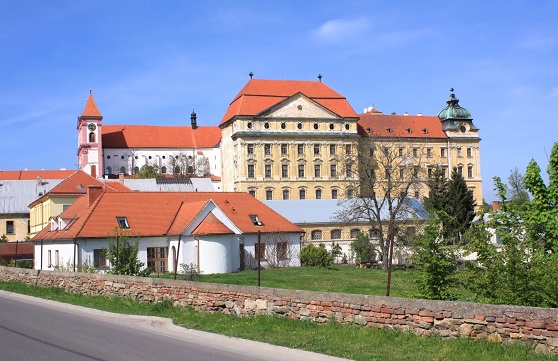
Znojmo hopes that there will be more grants for the monastery as a national heritage site.
 |
| photo: www.turistika.cz |
Znojmo - The government today declared the Loucký Monastery in Znojmo a national cultural monument. The city hopes that this will lead to more funding for the restoration of the neglected baroque gem, said the city hall spokesperson Zuzana Pastrňáková to ČTK. The city has owned the site since 2010 and has, for example, changed the windows here.
“We submitted the application for national cultural monument status in March 2015 with the vision that if the Loucký Monastery area were to obtain this status, it would mean better starting conditions for applying for grants, whether they be national or supranational grant programs,” Pastrňáková stated.
The city has owned the Loucký Monastery since 2010 when it was transferred to Znojmo free of charge by the state. A condition was that the city would not transfer the property to other entities for a period of 20 years. Another condition is that the site must be used in the public interest. Since then, the city has been striving to improve the face of the monastery through gradual repairs. For instance, the former riding hall has undergone a complete reconstruction, and investments have also been made to repair the façade of the former stable. The amounts are in the millions of crowns.
The monastery area is now primarily used in the basement section of the new convent. Znovín Znojmo has a wine storage and store here. A guesthouse is being created in part of the former stable building, which is being built at the expense of a private entrepreneur.
According to Aleš Homola from the Brno office of the National Heritage Institute, the Loucký Monastery was one of the most significant in Moravia due to its age, princely foundation, extensive property endowment, and the political influence of its abbots. “The preserved architectural monuments are a testament to that. The remnants of the Romanesque and Gothic monastery, Renaissance modifications, and especially the colossal, unfinished late baroque completion of the convent buildings make the monastery in Louka one of the most significant architectural, historical, and cultural monuments not only of our state,” Homola stated. He also noted that the monastery's purely cultural, scientific, and artistic influence was enormous, and among the abbots was the inventor of the lightning rod, Prokop Diviš. The monastery library was purchased by Strahov Monastery after the convent was dissolved during the Josephine reforms and is now a pride of its famous library. “The declaration of the monastery in Louka as a national cultural monument is entirely appropriate and it is rather surprising that this act is happening only now,” Homola said.
The monastery was founded in 1190 by the Znojmo prince Konrád Ota and soon became one of the most important centers of spiritual and economic life in southwestern Moravia. Around the middle of the 18th century, it underwent extensive baroque reconstruction, in which many outstanding artists of the time participated. The monastery was dissolved during the Josephine reforms in 1784, and the buildings then served other purposes.
“The wealth of the monastery is reflected in its preserved form, which is in a way an illustrative textbook of architectural styles. From the Romanesque church crypt, which director Strach used eight years ago for an impressive scene in his crime drama Devil’s Lure, to the remnants of the early Gothic cloister, the grand late Gothic choir, the Renaissance basilica with three naves, and up to the monumental late baroque new convent, which once concealed the famous library hall,” historian Jiří Kacetl from the South Moravian Museum in Znojmo wrote to ČTK.
In addition to the Znojmo Monastery, the government today also declared the Crematorium and Columbarium at the Central Cemetery in Brno a National Cultural Monument.
The English translation is powered by AI tool. Switch to Czech to view the original text source.
0 comments
add comment
Related articles
0
29.11.2019 | Znojmo repaired the roof of the Loucký monastery, which was damaged by the wind
0
25.02.2018 | The Loucký Monastery will have 43 new, handcrafted windows
0
24.07.2017 | Workers have begun the restoration of another wing of the Loucký monastery
1
28.11.2016 | The southern wing of the Louka Monastery near Znojmo has new windows
0
24.11.2016 | National cultural monuments could include another 18 buildings
0
18.03.2015 | Znojmo wants to declare the monastery in Louka a national cultural monument
0
28.09.2009 | The Loucký Monastery in Znojmo has an interest from a foreign investor
0
05.07.2006 | The dilapidated Louka Monastery will be acquired by the town of Znojmo from the state
0
16.03.2006 | The Znojmo Town Hall wants to know from the citizens what to do with the monastery in Louka










